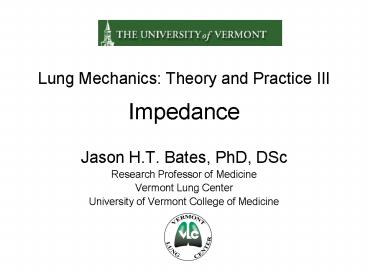Lung Mechanics: Theory and Practice III Impedance - PowerPoint PPT Presentation
1 / 20
Title:
Lung Mechanics: Theory and Practice III Impedance
Description:
Relaxed expiration in the anesthetized, paralyzed dog is bi-exponential. ... as well as an elastance, because it dissipates energy when it is deformed ... – PowerPoint PPT presentation
Number of Views:131
Avg rating:3.0/5.0
Title: Lung Mechanics: Theory and Practice III Impedance
1
Lung Mechanics Theory and Practice IIIImpedance
- Jason H.T. Bates, PhD, DSc
- Research Professor of Medicine
- Vermont Lung Center
- University of Vermont College of Medicine
2
A model prediction about passive expiration
3
Relaxed expiration in the anesthetized, paralyzed
dog is bi-exponential. (Bates et al. J Appl
Physiol 61 873-880, 1986)
4
Two exponentials implies two compartments
parallel model series model combination
5
Studies with the alveolar capsule in dogs (Bates
et al. J Appl Physiol 65 408-414, 1988), mice
(Tomioka et al. J Appl Physiol 93 263-270, 2002)
and other species showed that the normal lung
ventilated at normal breathing frequencies is
best described by a uniformly ventilated
compartment surrounded by viscoelastic tissue.
viscoelastic tissue
6
Lung tissue has a resistance as well as an
elastance, because it dissipates energy when it
is deformed
7
(No Transcript)
8
(No Transcript)
9
R and E depend on frequency
10
Impedance
f frequency R resistance X reactance E
elastance
11
Linear dynamic systems
12
A linear dynamic system treats the individual
sinewaves in the input as if they are alone. Each
input sinewave is scaled by an amplitude factor
and shifted by a phase factor that depend only on
frequency.
13
The impedance of the single-compartment linear
model
14
The impedance of the single-compartment linear
model including the inertance of the air in the
central airways
15
(No Transcript)
16
Alveolar capsule measurements demonstrate that
Raw estimated using the constant-phase impedance
model matches a direct measurement of Raw.
17
(No Transcript)
18
Summary 1
- Normal lungs are significantly better described
by a two-compartment model than a
single-compartment model - Tissue viscoelasticity is the main contributor to
the two-compartment behavior in the normal lung - Lung tissue exhibits resistive as well as elastic
behavior when distorted
19
Summary 2
- Lung resistance and elastance depend on frequency
- Impedance is a complex quantity that
characterizes mechanical behavior over a range of
frequency - The constant-phase model describes the impedance
of normal lung tissue accurately
20
Summary 3
- Parallel heterogeneity (differences in regional
alveolar ventilation) cause R and E to increase
at low frequencies - Serial heterogeneity (shunting of applied flow
oscillations into distension of airway walls)
also causes R and E to increase at low frequencies































